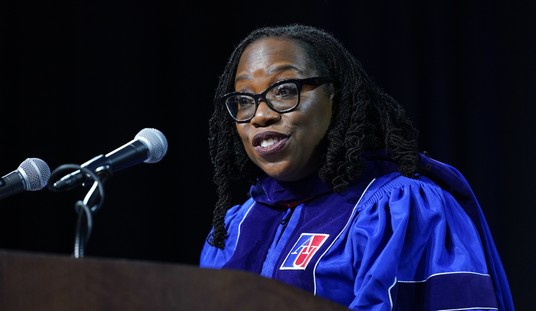Consider this a tacit endorsement of the new status quo on stare decisis at the top in dealing with restrictions on worship in the pandemic. The order overruling Andrew Cuomo’s COVID-19 rules for churches in Roman Catholic Diocese of Brooklyn got lots of heated debate in the concurrences and dissents leading to the 5-4 decision. It also drew heavy criticism as politically and culturally motivated jurisprudence, and some wondered whether the court would adhere to it in following cases.
Wonder no more. In a brief order this morning, the Supreme Court told the Ninth Circuit to reconsider its ruling upholding similar restrictions in the Harvest Rock Church case in California. The case had a pending cert petition, but instead the court vacated the original ruling and instructed the appellate court to remand it back “for further consideration in light of Roman Catholic Diocese of Brooklyn v.
Cuomo.” That seems like a pointed message, especially without any attached dissent:
The Supreme Court on Thursday sided with a California ministry that argued the state’s Covid-related restrictions on indoor services violated its religious liberty rights, the court’s second such ruling on pandemic guidelines for churches in two weeks. …
In the case at hand, the California ministry charged that Newsom, a Democrat, continued to impose “draconian and unconscionable prohibitions” on the lives of Californians and they accused the Governor of disregarding the restrictions “at his own whim.” …
A lawyer for the church said that while religious worship is at times “severely restricted,” grocery stores, big box retails stores, laundromats and warehouses do not have similar restrictions.
“The disparate treatment of religious as compared to similar nonreligious congregate gatherings unquestionably and substantially burden the Churches’ exercise of religion and violates the First Amendment,” the lawyer said.
California Attorney General Xavier Becerra rejected the church’s allegations telling the justices that the restrictions also apply to museums, movie theaters and restaurants. He also noted that there is currently a new surge spiking.
That doesn’t make matters as final as CNN might suggest, but it’s pretty clear what direction matters will take now. SCOTUSBlog’s Amy Howe notes that the order is in response to a request from the state to have the lower court re-evaluate their earlier ruling in light of RCDoB. They apparently didn’t want the same court to produce a final ruling after seeing what happened to Cuomo. The court accommodated California’s request, but made it clear that it intended RCDoB as precedent:
Last week the Supreme Court granted requests from the Roman Catholic Diocese of Brooklyn and two Orthodox Jewish synagogues to lift New York’s coronavirus-related attendance limits on worship services. The broader impact of that ruling became even more apparent on Thursday morning, when the justices ordered a federal district court to take another look at a southern California church’s challenge to that state’s restrictions on indoor worship services. …
The state suggested that before the Supreme Court rules on the church’s request, it should allow the lower court to “promptly evaluate” the church’s arguments in light of last week’s decision in the New York case and “the current factual and legal circumstances in California.”
The justices did exactly that on Thursday morning, with a brief two-sentence order. There were no public dissents from the ruling. The justices have two other pending requests for relief from COVID-related restrictions, involving houses of worship in New Jersey and a Christian school in Kentucky.
Presumably, California thinks its set of facts and circumstances will differ enough to keep the original ruling in place. Perhaps it might, but the governing opinion in RCDoB (not the concurrences) emphasized that “strict scrutiny” has to be applied in cases where tighter restrictions are applied to houses of worship than to commercial businesses with similar situations:
Because the challenged restrictions are not “neutral” and of “general applicability,” they must satisfy “strict scrutiny,” and this means that they must be “narrowly tailored” to serve a “compelling” state interest. Church of Lukumi, 508 U. S., at 546. Stemming the spread of COVID–19 is unquestionably a compelling interest, but it is hard to see how the challenged regulations can be regarded as “narrowly tailored.” They are far more restrictive than any COVID–related regulations that have previously come before the Court,2 much tighter than those adopted by many other jurisdictions hard-hit by the pandemic, and far more severe than has been shown to be required to prevent the spread of the virus at the applicants’ services. The District Court noted that “there ha[d] not been any COVID–19 outbreak in any of the Diocese’s churches since they reopened,” and it praised the Diocese’s record in combatting the spread of the disease. ___ F. Supp. 3d ___, ___, 2020 WL 6120167, *2 (EDNY, Oct. 16, 2020). It found that the Diocese had been constantly “ahead of the curve, enforcing stricter safety protocols than the State required.” Ibid. Similarly, Agudath Israel notes that “[t]he Governor does not dispute that [it] ha[s] rigorously implemented and adhered to all health protocols and that there has been no outbreak of COVID–19 in [its] congregations.” Application in No. 20A90, at 36.
Not only is there no evidence that the applicants have contributed to the spread of COVID–19 but there are many other less restrictive rules that could be adopted to minimize the risk to those attending religious services. Among other things, the maximum attendance at a religious service could be tied to the size of the church or synagogue. Almost all of the 26 Diocese churches immediately affected by the Executive Order can seat at least 500 people, about 14 can accommodate at least 700, and 2 can seat over 1,000. Similarly, Agudath Israel of Kew Garden Hills can seat up to 400. It is hard to believe that admitting more than 10 people to a 1,000–seat church or 400–seat synagogue would create a more serious health risk than the many other activities that the State allows.
This is the well-known test explicitly imposed by Religious Freedom Restoration Act (RFRA) laws. Those do not bar restrictions on religious expression entirely, but require the state to show that (a) there is a compelling state interest in place, and (b) the law is as narrowly tailored as possible to serve that interest while allowing for full use of the constitutionally protected right otherwise. Any restrictions that provide more flexibility to, say, acupuncture clinics than churches will necessarily fail that test.
And they should, write Michael McConnell and Max Raskin at the New York Times. Cuomo’s ridiculously arbitrary rules made a mockery of constitutional rights regardless of what one thinks of the current composition of SCOTUS. Moreover, the last-minute gambit by Cuomo to moot the case should not have been rewarded, which McConnell and Raskin argue was the actual split in the decision, not the strict-scrutiny requirement:
The real disagreement between Chief Justice Roberts and Justice Breyer and the majority was over a technical though important detail. This disagreement made the court look more fractured than it actually was. Just days before the decision, on Nov. 19, the governor’s lawyers sent the court a letter stating that he had redrawn the red and orange zones in Brooklyn, conveniently putting the churches and synagogues that were the focus of the litigation into the more permissive yellow zone. The letter cited no reasons for the reclassification and offered no assurance that it might not happen again, at a moment’s notice, with no more explanation than this time.
The court majority regarded the governor’s about-face as too fleeting and changeable to derail a decision on the merits. Chief Justice Roberts and Justice Breyer, by contrast, concluded that the change eliminated any need for the court to intervene, at least for now. That is a reasonable position (though we disagree with it) — and it does not indicate any fundamental disagreement with the five justices in the majority about the need to protect civil liberties even in a time of emergency.
Perhaps Chief Justice Roberts and Justice Breyer believed that Governor Cuomo and government officials around the country will read the court’s opinions and recognize that it is time to bury the meat cleaver and begin to regulate constitutional freedoms with a scalpel — without the need for a judicial order.
That message is lost if the case is seen as the mere product of Justice Amy Coney Barrett’s arrival at the Supreme Court. With the presidential election behind us, the balance between Covid-19 precautions and civil liberties no longer needs to be a partisan issue. The right to exercise religion in accordance with conscience is one of the most important in the Bill of Rights, and it is time for mayors and governors — and courts — to treat it that way.
Indeed. The opposition in RCDoB is more about whether this was the case in which to draw that line. Now that it has been drawn, though, the whole court seems intent on enforcing it.








Join the conversation as a VIP Member